In an unprecedented campaign, thousands of Bangladesh’s garment factories are struggling to become safe places to work
At a garment factory on the outskirts of Dhaka, young men screen print the words “Holly Whyte” onto white tank tops laid on a long table. They push screen printing frames over each shirt, one by one, rhythmically thwacking the wood against the table. Slogans on some shirts are incongruous with the surroundings—picture T-shirts that say “Never Tired” being made in a country whose minimum wage is $68 a month. In particular, the words “Holly Whyte” catch my eye. Before it was the name of a Final Fantasy character, Holly Whyte was a real person, an American urbanist who coined the term “groupthink”. I wonder what Whyte, author of books like “The Exploding Metropolis” and “The Organization Man”, would think about the changes afoot in thousands of factories like this one.
Bangladesh, whose garment industry is second only to China’s in size, is responding to both international and domestic pressure and undergoing the most radical revamping of worker safety it has ever seen. The south Asian country is almost halfway through a five-year plan to bring more than 3,500 export garment factories up to international safety standards by 2018. More than 200 of the world’s biggest clothing brands and retailers—including H&M, Walmart, Target, Zara, Marks and Spencer, Adidas, L.L. Bean, and Benetton—have pledged to do business only with factories that comply.

It’s a Herculean task in a country where safety seems an alien concept. Walk down the street in Dhaka, the teeming capital of 15 million, and it’s common to see laborers in flip-flops cutting re-bar with power saws as sparks fly toward unshielded faces. Unharnessed construction workers scale flimsy scaffolding on tall buildings. Taxi drivers routinely rip out seat belts from the back seat.
Although progress at export garment factories varies widely, the safety overhaul is urgent and real. On April 24, 2013, an eight-story building called Rana Plaza collapsed with thousands of garment workers inside. More than 1,100 people died and 2,500 were injured in the world’s worst factory disaster. Grisly images of workers crushed and maimed under concrete and steel filled television screens and newspapers around the world. Many victims were young women. The garment industry employs more than 4.5 million people in Bangladesh, 80 percent of whom are women.
It’s a critical time in Bangladesh as garment factories struggle to transform in order to prevent another tragedy like Rana Plaza. The scale of the task and the speed needed to tackle it is “unprecedented,” said Tuomo Poutiainen, program manager with the International Labor Organization (ILO), based in Dhaka. “You don’t see anywhere else in the world doing this as quickly.”
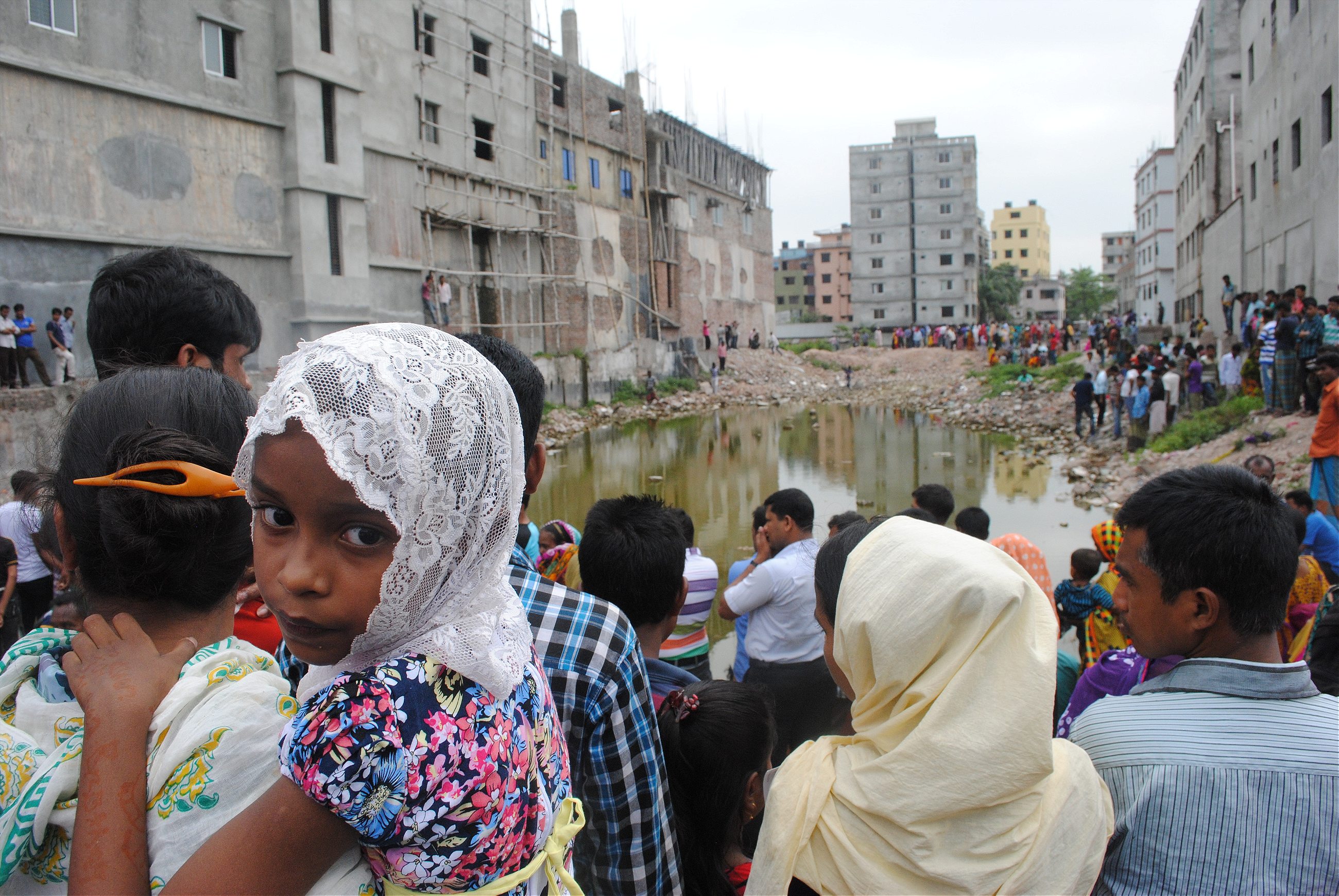
Governments in North America and Europe are pressuring Bangladesh’s government and factories to step up. Aid agencies, non-profits, labor rights groups, and other organizations are in Bangladesh training safety inspectors, emergency personnel, union members, factory management, and workers.
International clothing brands are funding inspections and oversight at the majority of factories through two groups. The legally-binding Bangladesh Accord on Fire and Building Safety covers some 1,250 factories used by more than 190 mostly-European brands such as H&M, Tesco, Primark, Benetton, and Inditex, owner of Zara. The Alliance for Bangladesh Worker Safety, includes about 700 factories used by 26 of the biggest U.S. clothing buyers including Walmart, Target, Gap, Costco, Sears, and The Children’s Place. About 1,400 factories not under the Accord or Alliance brands are inspected by the National Tripartite Plan, which is backed by the Bangladeshi government and the International Labor Organization.
More than 3,000 out of 3,500 export factories had been inspected by July. As of March, thirty-two factories out of the 2,700 facilities inspected at the time were closed due to imminent risk. Now factories are working through lists of problems to fix. A few are done or almost done. Many more are still fumbling their way through the “remediation” process, which is expensive and technically confusing. Some factories are unresponsive.
If customers think they’re killing people while making their blue jeans, they won’t buy them
It’s an uphill battle, but one with far-reaching repercussions. The garment industry has driven Bangladesh’s economic growth of six percent in recent years and accounts for 80 percent of exports. Factory work is a grind, but it plays an important role in reducing poverty by creating millions of steady jobs in a country where the majority of people live in rural areas and eke out a living from agriculture. Development and public health experts credit garment factory jobs with helping to improve the lives of the poor. It is one of just a handful of countries that will meet the UN’s Millennium Development Goals to reduce deaths of young children and new mothers. And it reduced maternal mortality by a staggering 40 percent in two decades.
For huge clothing brands whose business relies on image, there’s a simpler reason to improve factories. “If customers think they’re killing people while making their blue jeans, they won’t buy them,” one American safety expert told me.
In three years, Bangladesh must make thousands of export garment factories safe, improve workers’ rights, and create a regulatory system sustainable beyond 2018. New legislation in the works to improve worker safety and health also includes many other industries, ranging from pharmaceuticals to food processing. If Bangladesh succeeds, it could set an example for other countries that must improve woeful workplace safety and health.
Major changes are not inconceivable. Against the odds, Bangladesh has already achieved many important development milestones. But success cleaning up the garment industry, just two years after the Rana Plaza disaster, is by no means guaranteed. As Brad Loewen, the Accord’s chief safety inspector, told me, “Three years is an optimistic timeline to go from nothing to a trained inspectorate that has teeth. You hope you can do it quicker, but the reality is that these things are just not quick.”
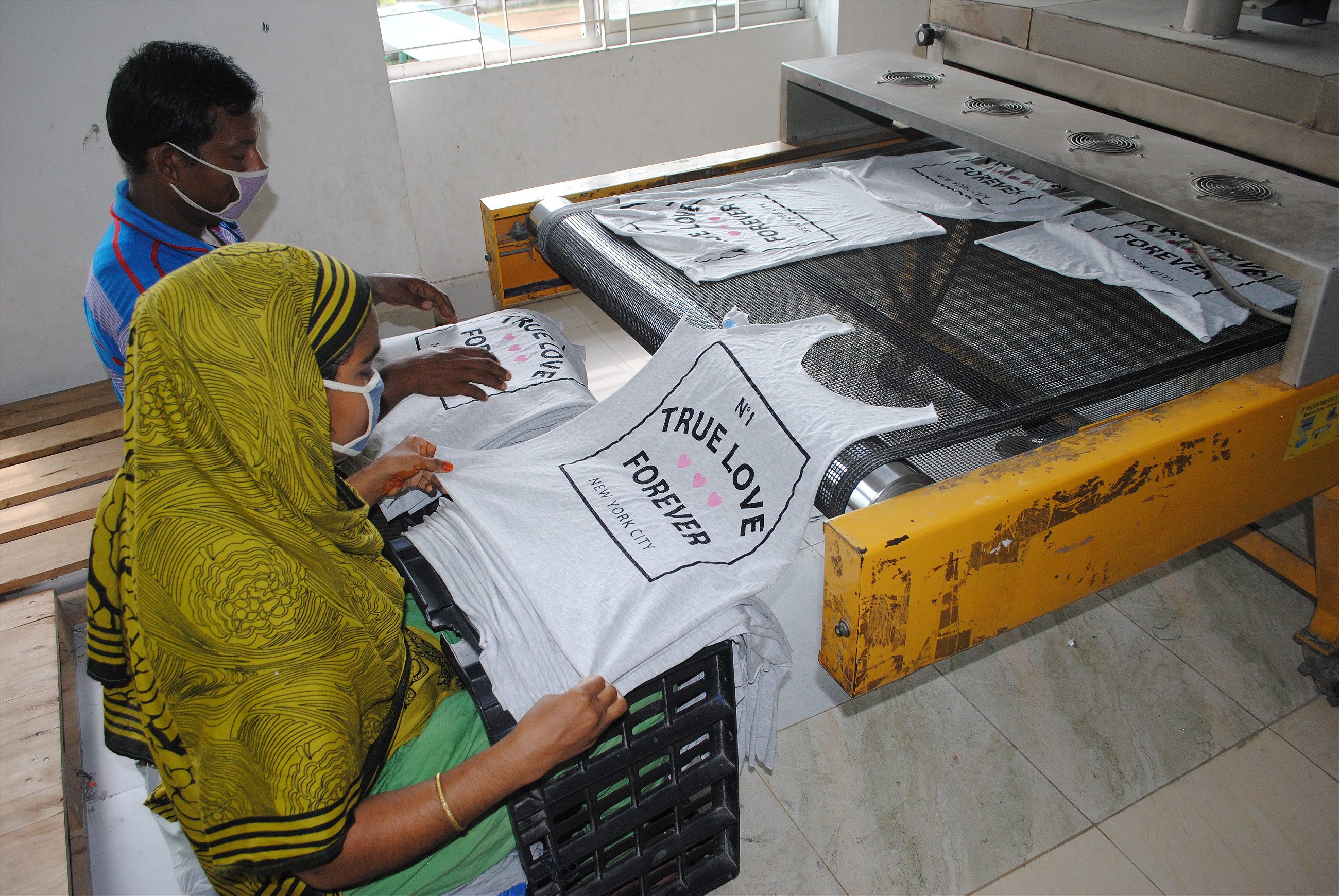
Shahjahan Selim vividly remembers the morning Rana Plaza collapsed. Selim, a factory supervisor, was on the fifth floor when the ceiling caved in around him. Moments before, a generator had rumbled to life after a power outage, a common occurrence in Bangladesh. The whirring sound of hundreds of sewing machines on the factory floor halted.
Then a strange vibration shook the building. Selim, a 37-year-old father, heard a tremendous noise as the world plunged into darkness. He was thrown to the floor alongside fellow workers. Some died quickly when concrete and metal crushed them as the building imploded.
Unhurt, Selim staggered to his feet and started clawing out of the rubble. Then he heard moans and shouts. “Please save us,” people called.
For the next two weeks, Selim went back into the nightmarish ruin of Rana Plaza. He rescued 37 people and removed 28 bodies from the treacherous tangle of broken concrete, twisted steel, and ripped electrical wires. Those still trapped in the wreckage begged for help.
Selim remembers a 30-year-old woman whose arm was pinned beneath concrete. As he struggled to free her, they learned each other’s names. “My dear Selim, brother,” she cried. She told him she was a mother. With a saw, Selim cut off her arm near the shoulder to release her.
The last person Selim rescued was a man trapped beneath concrete slabs. But then Selim slipped and fell from the fourth floor, severely injuring his spinal cord and limbs. He was hospitalized for months and couldn’t walk. After more months of physical therapy, Selim can now walk with a cane, but has limited movement in one of his arms.
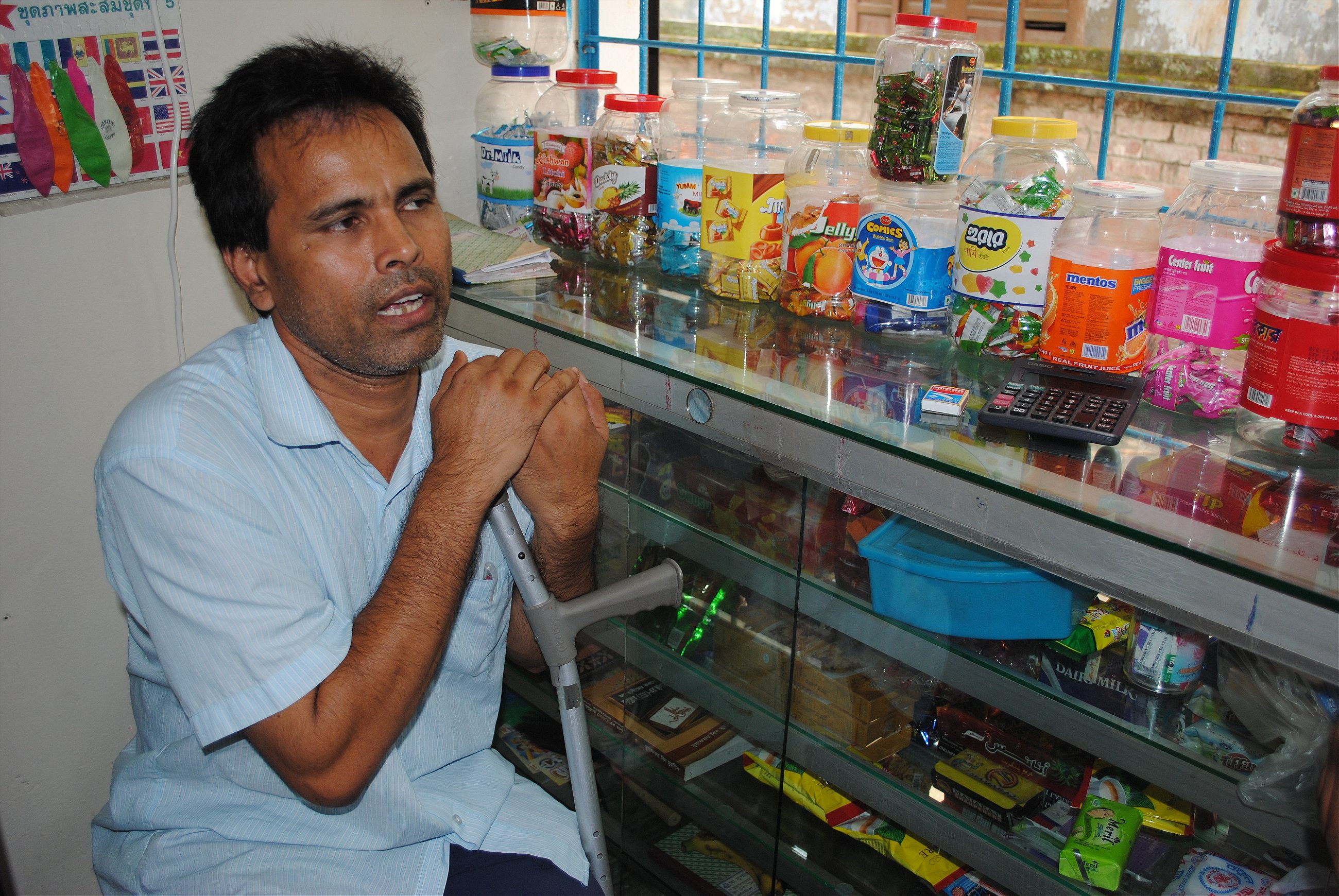
On a hot spring day, Selim sits on a stool in his well-stocked grocery corner store not far from Rana Plaza. Selim opened the store with grants from international non-profits and other agencies that are helping survivors. Selim hunches slightly against his metal cane.
In the quiet lane outside the shop, a customer approaches. “Selim, brother,” he says in Bangla and asks for two cigarettes. Selim’s hand trembles as he passes the cigarettes through the store’s blue metal grate. His movement is limited so customers scoop and weigh rice and lentils from open sacks and make their own change from a plastic box. All kinds of sundries fill the shelves: Pepsodent toothpaste, Lactogen baby formula, Mirinda orange soda, packets of Horlicks chocolate milk powder, bags of balloons, tubes of yellow tennis balls, Jac Olivo oil, and jars of Mentos candies.
A boy stops by and asks for a popsicle. A woman requests a packet of laundry detergent.
When Selim recalls the disaster, though, he is remarkably understated. “Government should not permit this type of building,” he says. “We lost many lives… I want to see a garment industry where workers are safe.”
At Bangladesh’s better garment factories, safety measures have existed. But even those don’t usually meet strict international standards. The worst factories are unsafe and unhealthy or downright dangerous.
Alif Embroidery Village, a smallish factory of 1,800 workers in an industrial area of Dhaka called Savar, is one of the better ones. It makes clothes for Gap, Target, Next, C&A, Zara, and many other brands. I visit the factory on a sweltering day as sweat streams down my back and legs. I’m with a group of safety experts from the Alliance. We troop from floor to floor of the tidy facility, looking at new fire extinguishers, circuit boxes, and other equipment.
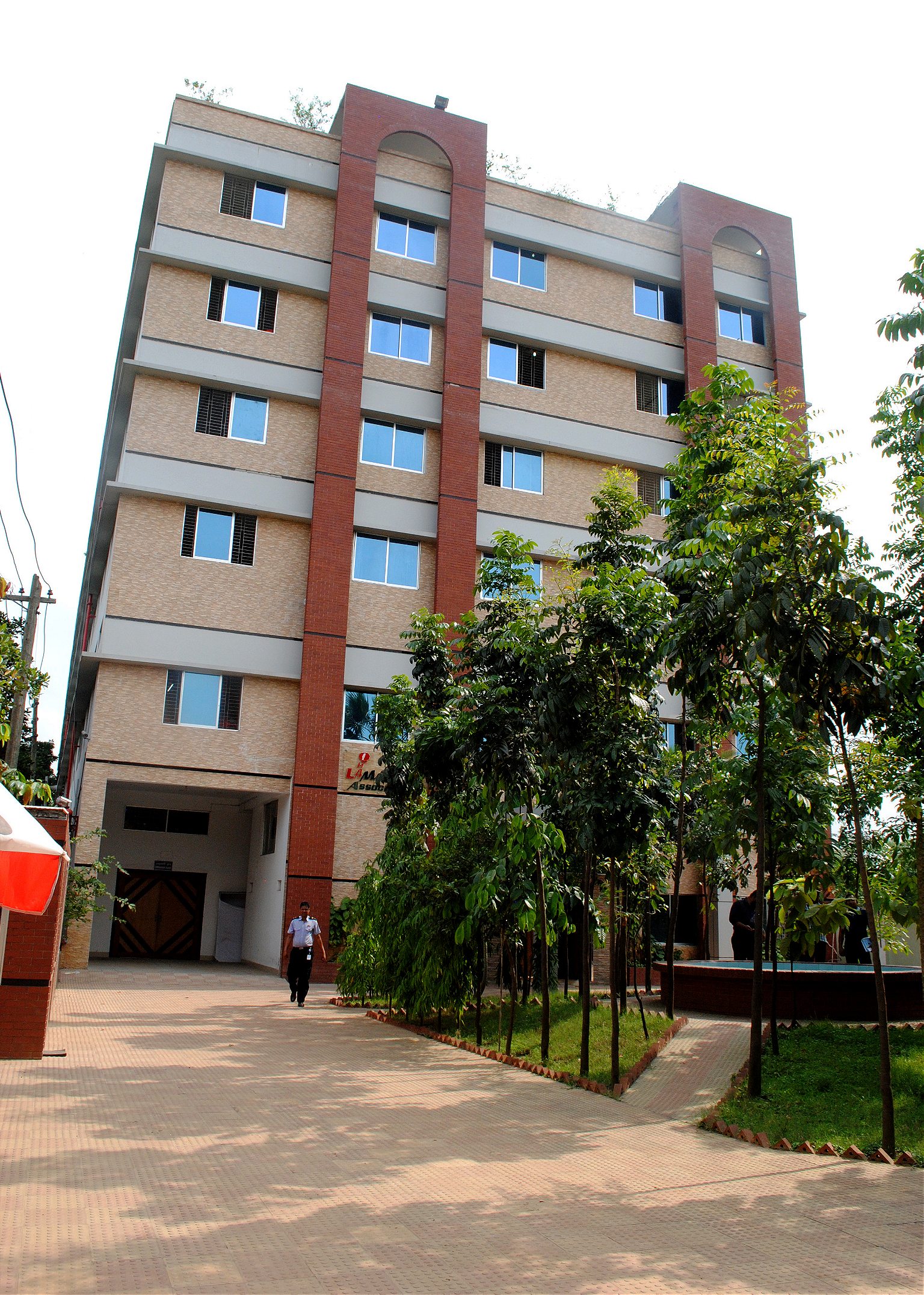
Fire doors are so new they still have plastic wrapping on them. These were all imported; fire doors and other certified fire safety equipment, such as sprinklers and high-tech fire alarms, aren’t available in Bangladesh. One fire door costs about $1,200. A small factory can easily spend tens of thousands of dollars just on specialized fire doors that are designed to withstand heat and equipped with hinges that won’t warp in a fire.
Mark Chubb, chief safety officer of the Alliance, was previously president of the U.S. branch of the Institution of Fire Engineers based in Seattle, as well as a county fire chief. He points out the metal plaque in the doorjamb with a serial number that attests the door is authentic. Bangladesh has a bustling industry of counterfeit products, ranging from fake branded clothing to “Doreo” cookies.
Crucially, these doors can be opened from the inside even if locked from the outside. Metal “accordion” security gates are the norm in Bangladesh. Accordion gates turn factories into death traps if they are kept locked with people inside. In November 2012, at least 112 people died in a fire at Tazreen Fashions garment factory in Dhaka in part because of locked doors.
Export factories are inspected by fire, electrical and structural engineers from the Accord, the Alliance, or the National Plan who compile lists of problems to fix; the lists are then posted online and updated. Factories often hire private audit firms with engineers to help them upgrade.

At Alif Embroidery Village, yellow lines on the floor mark where aisles must be kept clear. Some garment workers wear bright vests designating them as specially trained fire safety ‘captains.’ An expensive sprinkler system will be installed even though the six-story factory is not required to have one (they’re mandatory only in factories of certain heights, usually seven stories or higher).
More than 70 percent of factory fires are caused by bad electrical wiring that sparks and catches fire. Proper wiring and fireproof metal circuit boxes are crucial. Many fires could also be prevented if factories were kept free of flammable lint that accumulates like powder snow. “Getting the highly-flammable lint and dust off wiring systems and off the areas around the circuit boxes is a huge preventive measure,” says Rob Wayys, executive director of the Accord.
On the ground floor of Alif Embroidery Village, rows of machines automatically embroider thousands of hearts onto fabric. Other machines knit terrycloth loops into green tank tops that spell out “LA” in fuzzy letters.
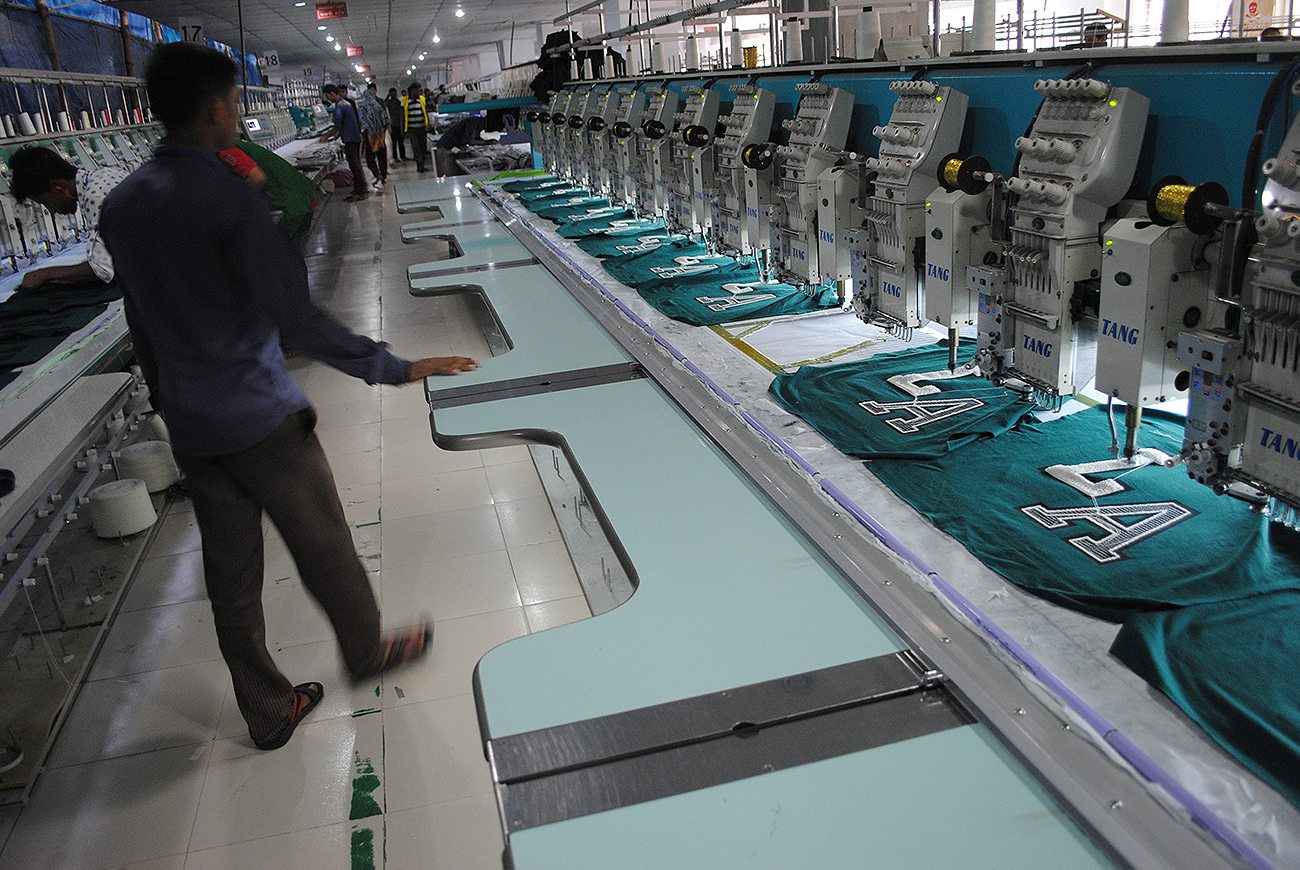
At the end of the aisle, a large hole has been carved in the floor around a concrete support pillar. I can see a couple men in hard hats in the hole amid a web of steel rebar. More than 30 columns will be reinforced with steel and concrete.
Outside are two $60,000 hydrant pumps that can carry water from a new reservoir in the basement up pipes and fire hoses. The factory has also built a brick room to separate its generator from a nearby storeroom where fabric was once stocked. Previously, there was nothing separating the diesel generator and mounds of flammable material.
The factory has also redistributed mountains of fabric stored in the factory or shipped them offsite. Relieving factories of unnecessary, heavy loads is a revelation to managers. Rana Plaza, like many buildings in Bangladesh, kept huge water tanks and generators on its roof. The vibrations of the generators that were switched on after the power outage were the final straw for the weak and overloaded building.
In all, Alif Embroidery Village will spend about $1.4 million dollars on upgrades. Mohammed Akter Hossain, Alif’s chairman, doesn’t seem phased. “We want to run a good business. We feel it is an investment,” he says. Managers’ offices, including his own, are in the same building as the factory, he points out. “We spend 10 to 14 hours here every day. This is an important place.”
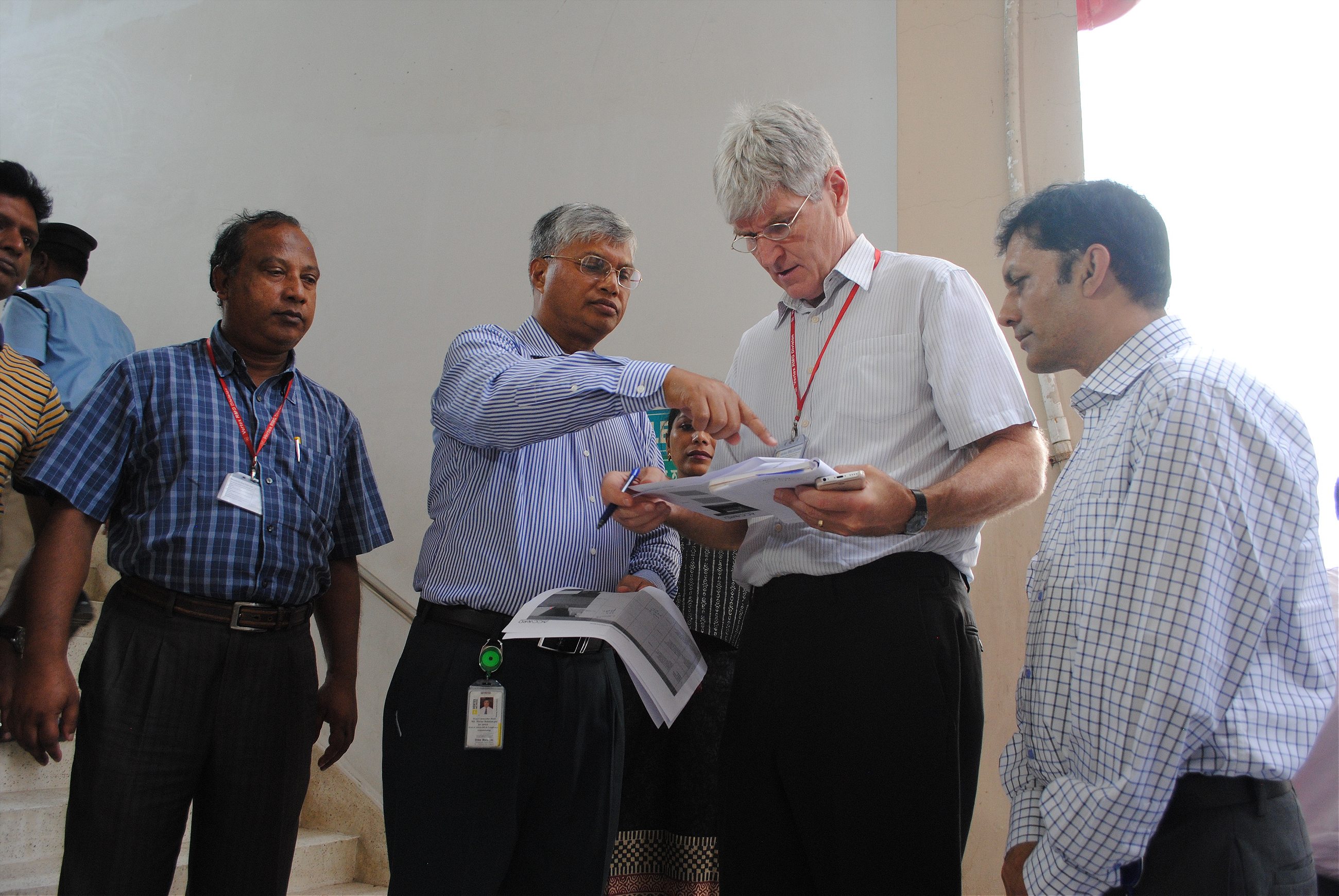
A few weeks later, I visit a factory called Vertex with Loewen of the Accord. Vertex has spent $1.2 million on upgrades and the factory, which makes clothes for Old Navy, H&M, Carrefour, Men’s Wearhouse, and others, is on track to be one of the first to meet international safety standards after nearly a year of work. During a walk-through of the factory in Savar, Vertex managers surround Loewen, a white-haired Canadian previously in charge of fire inspections for the city of Winnipeg.
Within the factory of 4,500 employees, each floor buzzes with activity. Women inspect stacks of plaid fabric on a long table. Sewing machine operators stitch white shirts beneath a big Tesco sign. A woman sweeps the tiled floor with a contraption made of a large piece of cloth pushed by poles held in each hand. Workers eye me as I chase the woman to get photos of her sweeping the lint spit up by hundreds of churning sewing machine needles.
On the ground floor of Vertex, pallets of fabric are visible through open doorways of storage rooms. New fire doors are magnetized so if there is a fire, the centralized smoke alarm systems can pinpoint its location and remotely close off doors. The inspection team checks new electrical cables and looks at handheld thermal scanners that can detect where electrical wiring is overheating.
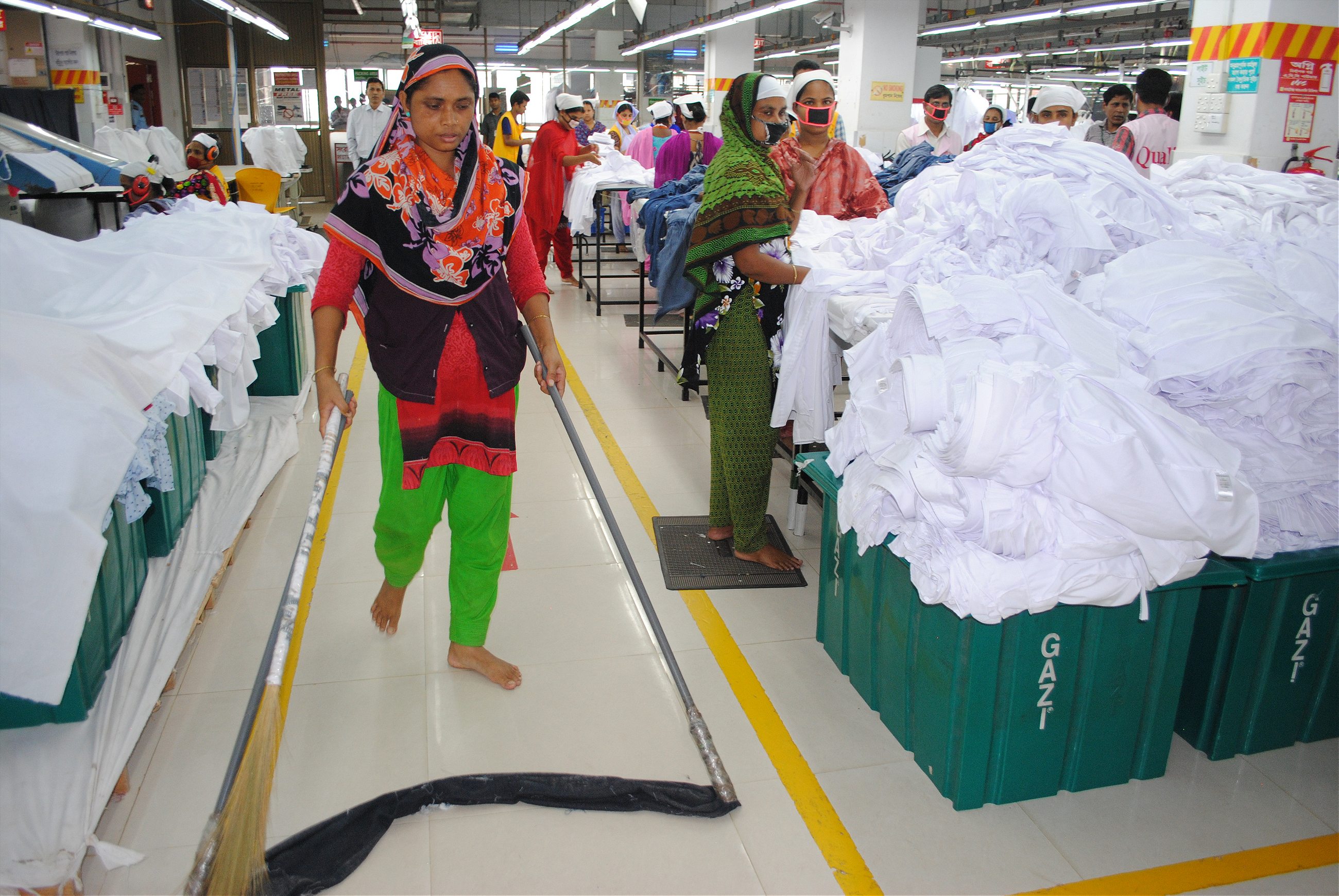
Foreign inspectors like Loewen seem to alternate between being encouraged at the progress and flummoxed by how slow it comes. “The amount of things corrected overall is not great. On one hand, it is disappointingly low,” Loewen told me. On the other hand, since inspections started, “The amount of work done has been incredible. Where we are compared to where we started — we’re way down the road. It’s impressive,” said Loewen. “Next year factories will be much, much safer.”
The Vertex factory’s structural safety is excellent. “We have no concerns about collapse. It’s a very good building structurally,” says Loewen. Vertex owns its factory, which sits on a multi-acre plot amid scraggly fields. That helps with maintaining control over building construction and maintenance. However, many factories lease space in shoddily constructed high rises and have little control over structural safety. Garment factories that do pass final inspections will be safer than most of Bangladesh’s schools, hospitals and other municipal buildings.
So far the cost of remediation hasn’t dented Bangladesh’s garment industry, which grew four percent from $23.5 billion in 2013 to $24.5 billion in 2014, according to Bangladesh’s Export Promotion Bureau. The industry is expected to grow even more this year. Costs are still low and the country has a vast supply of young workers; more than half the population of 160 million people is under 25.
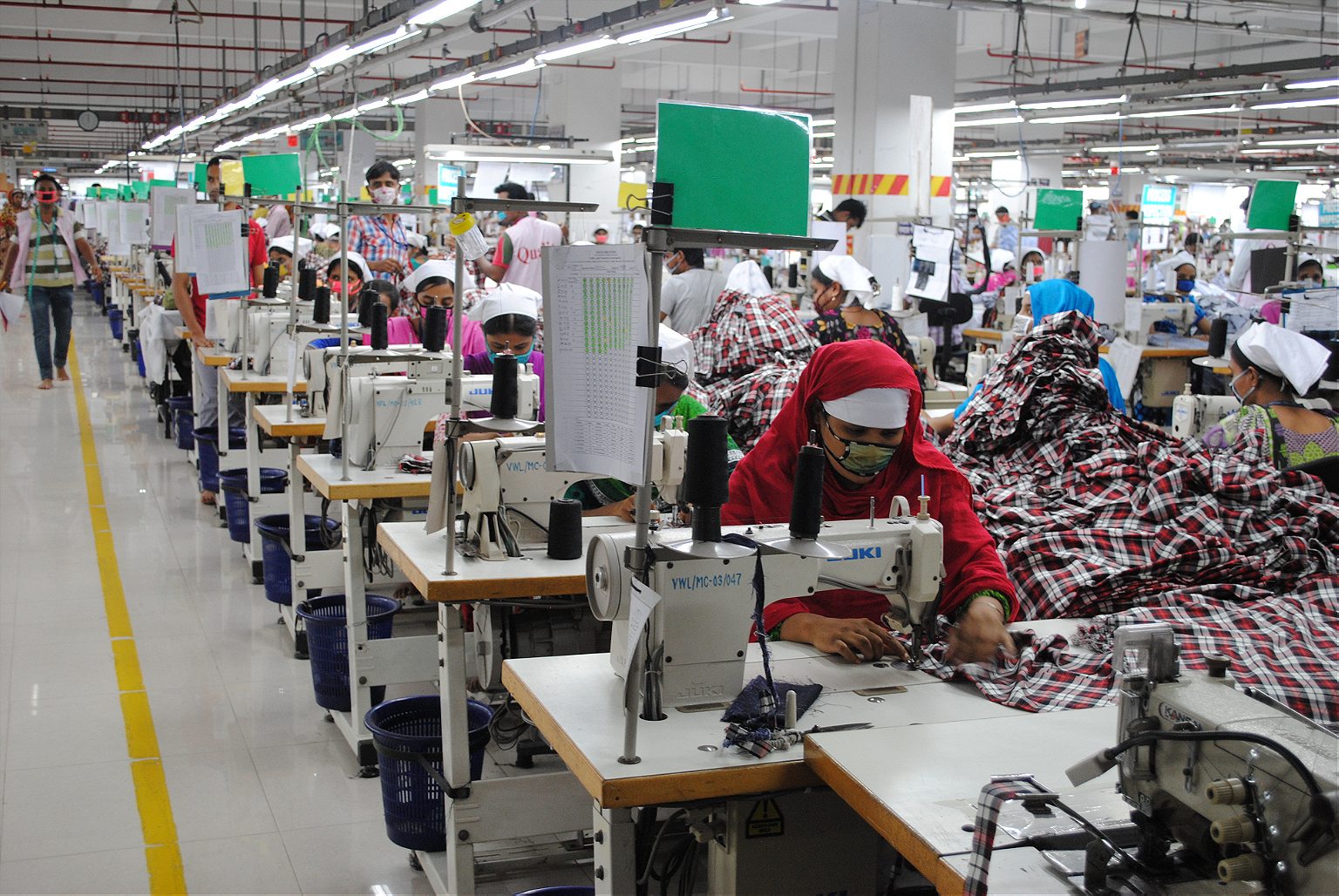
Reaz Bin Mahmood, vice president of finance at the Bangladesh Garment Manufacturers Export Association, a powerful industry lobby, claims safety wouldn’t be any better in countries where costs are cheaper. At his office, he looks at a handout listing garment exports to the U.S. from various countries. “Look at this!” he cries pointing to a line with Pakistan’s export numbers. “This is a Taliban country!”
Bin Mahmood, youthful and talkative, doesn’t hide his frustration. Larger, well-financed factories may be able to spend upward of $1 million dollars on remediation. But strained smaller factories can’t afford that and need low-interest loans and other assistance. (A few months later in July, the International Finance Corporation, the World Bank’s private sector arm, announced it will provide $50 million in loans.)
What’s more, factory owners are exasperated by confusing and conflicting instructions about remediation, says Bin Mahmood. Lists of problems to be fixed keep changing and owners don’t have enough support to comply with technical problems. Buying the correct fire doors has been a common source of friction. There is also controversial debate about how newly mandated worker safety and health committees in factories will be formed.
Without more support, more factories will shut down, Bin Mahmood says. “If more factories close, I don’t know where all these women”—garment workers—“will go.” He doesn’t mention the loss of a lucrative source of income for factory owners.
Less than five percent of all garment workers are represented by unions
A looming question is how safety standards will be maintained in the future. The Alliance and Accord are five-year pacts that end in 2018, though the National Plan will continue with support from the ILO. International agencies are helping to train government inspectors. After Rana Plaza, the government recruited 218 labor inspectors to join the existing team of 68. An additional 45 inspectors were being recruited this spring. Worker hotlines have been set up by the government and the Alliance.
Empowering workers is part of the answer, say both the ILO and the Accord, which also includes global labor unions. Workers will be the eyes and ears at factories, says Poutiainen of the ILO. “They are most important because they are the ones on the ground.”
That means that alongside factory safety, the larger, longer-term challenge of workers’ rights in Bangladesh also has to be addressed. Empowering workers in this hierarchical society is a unique challenge. Less than five percent of all garment workers are represented by unions, even with significant recent union growth.
Between 1991 and 2006, there were 136 registered unions in the garment industry but only seven were active by 2010. As of May 2015, there were 300 registered unions with about 200 active. They represent some 150,000 workers.
Members and leaders are joining groups like Bangladesh Independent Garment Workers Union Federation (BIGUF), the largest federation in Bangladesh’s garment industry. It has more than 12,000 members compared to 4,800 before 2012.
Friday is a day of prayer in Bangladesh and the only day off for most garment workers. But Friday is also the busiest day at BIGUF’s office in the industrial Gazipur district on the edge of Dhaka. A couple dozen young union leaders gather in the modest office tell me their main problems, which include late or irregular salaries, no paid time off or maternity leave, lack of clean drinking water, and dirty toilets.
Rosina became a union leader in spite of initial protests from her family. “Trade union is our right,” she says like a mantra.

Negotiations with management have improved working conditions at some factories. Asan Ali, a sewing machine operator, says his factory installed ceiling fans after talks between management and workers. It also began offering 20 days of paid leave to garment workers.
But labor unions face resistance. In the worst cases, union members are harassed or intimidated. The most high-profile case was the 2012 abduction and brutal murder of labor activist Aminul Islam of the Bangladesh Center for Worker Solidarity.
Mention labor unions to factory owners and they get tense. There are legitimate concerns about whether growing unions could be hijacked for political interests in a country notorious for cutthroat politics. This year, political conflict sparked 81 days of blockades and 67 days of volatile national strikes. More than 100 people died this year in roadside bombings.
And truth is that ensuring workers’ rights is not as easy as demanding more unions. There is also the challenge of how to create effective unions. New leaders need training and support on everything from running meetings to negotiating salaries to resolving disputes. In their new roles they will lead hundreds of garment workers, many of whom have little education. It’s not a trivial role for the average union leader, who is 26 with an eighth grade education and likely hails from the countryside.
“The learning curve is steep,” says Alonzo Suson, program director of Solidarity Center in Dhaka, an AFL-CIO affiliate that is helping train BIGUF union leaders.
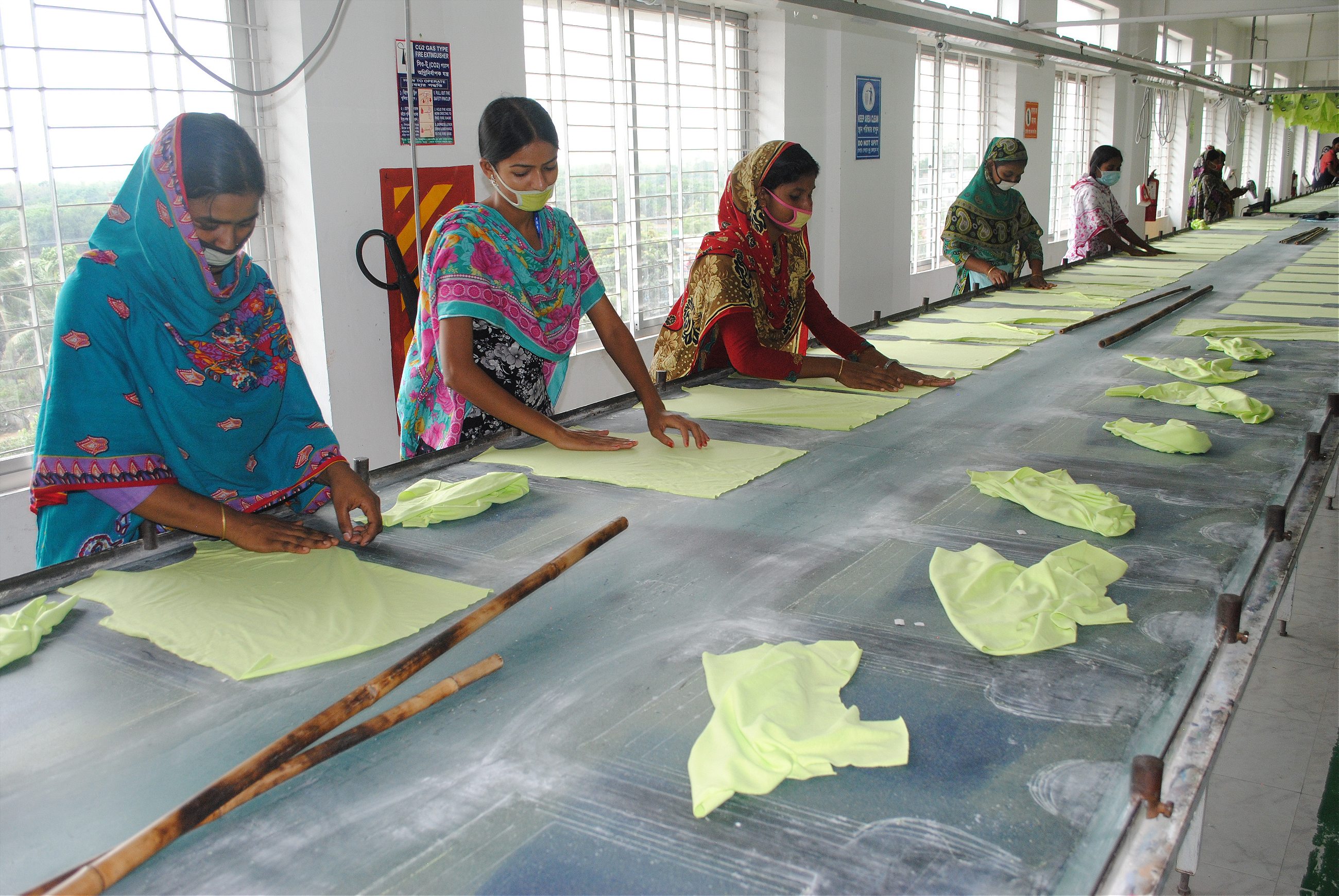
For Rehana Akter, the twelve hours that she was trapped under concrete in the ruins of Rana Plaza remain a blur of shock and confusion. The 24-year-old former garment worker remembers the moment when the building collapsed. She was working on the seventh floor when she suddenly felt herself moving, “like being in an elevator.” A roar engulfed the room and people started to run and scream. Rehana fell. She didn’t know which way was up or down. “It was like being in the middle of nowhere,” she says. After some time, Rehana realized she was under something heavy and her leg was twisted at an odd angle. Her leg was crushed. It was eventually amputated above the knee.
On a steamy spring day, Rehana is dressed in an orange salwar kameez during a visit to the Center for the Rehabilitation of the Paralyzed in Dhaka. She wears blue high-top sneakers instead of the sandals most Bangladeshi women wear. Rehana stiffly extends and flexes her prosthetic leg.
For months after the collapse, Rehana received treatment from the center, which was founded in 1979 and happens to be located near Rana Plaza. Last year she began walking with a prosthetic leg, but she still has trouble carrying large objects and finds it difficult to pump water in the village where she now lives.
In June, the Rana Plaza Donor Trust finally reached its $30 million target after an anonymous $3 million donation closed the lingering gap. The voluntary fund to compensate survivors and victims’ families includes donations from global clothing brands, the Bangladeshi government, and others.
But only half the clothing companies who did business in Rana Plaza contributed. The companies who did donate include Mango, Primark, Walmart, C&A and Zara, according to anti-sweatshop group Clean Clothes Campaign. Benetton was chastised for donating only $1.1 million in April—two years after Rana Plaza.
Compensation payments range from a minimum of about $625 and nine months of salary to more than $31,000, according to Mojtaba Kazazi, executive commissioner of the Rana Plaza Claims Administration. As of April, about 70 percent of compensation was paid to the 2,800 claimants.
Money alone is often not enough. Some female garment workers say their husbands left them for other women after taking their compensation, according to interviews compiled by the ILO. Others, like Rehana, still experience mental trauma or physical pain that makes it difficult to work.
Rehana received a cow from the Center for the Rehabilitation for the Paralyzed and livestock training as an alternative way to earn a living. But she and other survivors still can’t work full-time and their prospects are uncertain.
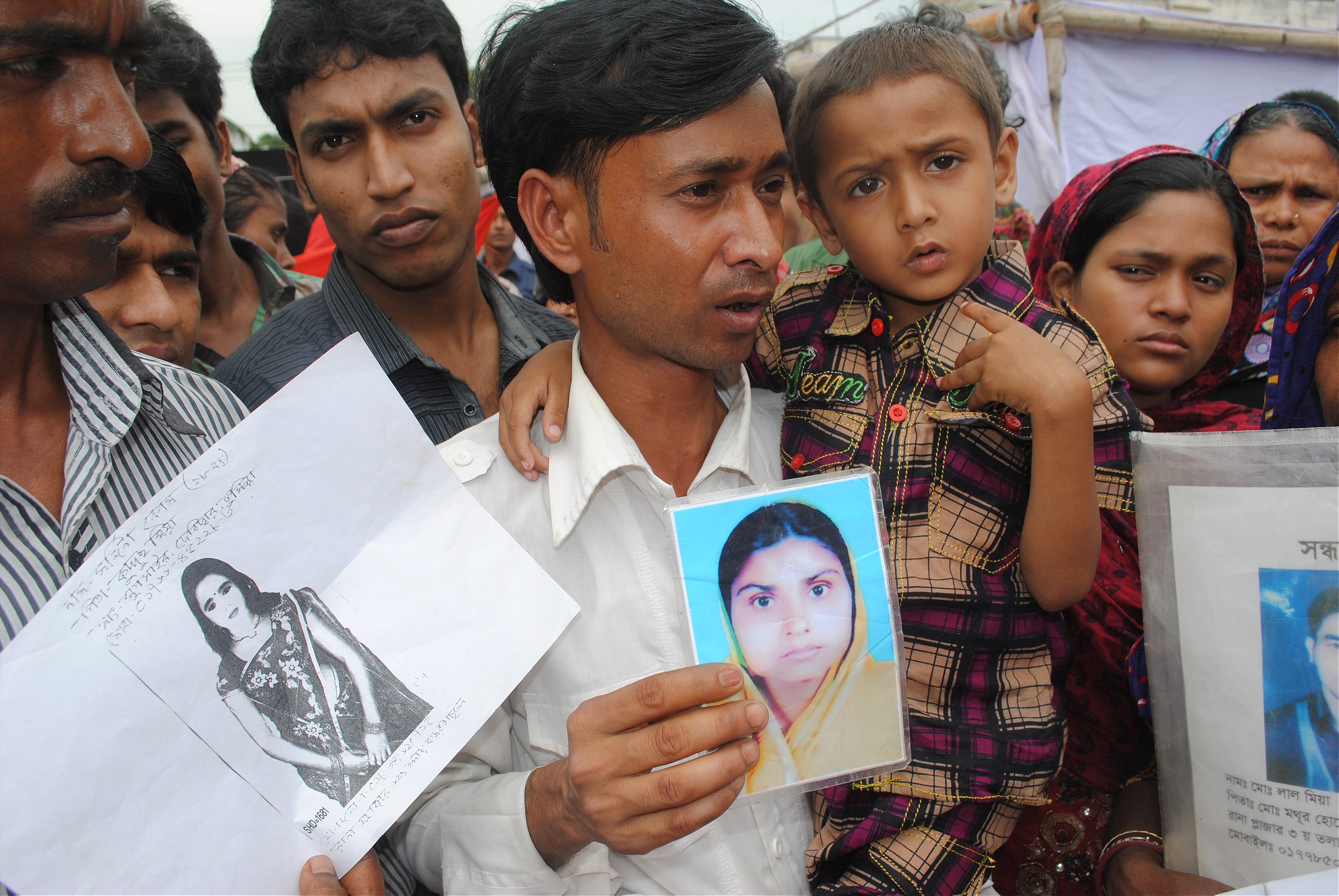
On a humid evening in central Dhaka, garment workers sit on the floor of the small office of the Awaj Foundation, a local non-profit. They shake dice over a game board and pick cards with questions such as “How many days of notice do workers have to give before resigning?” and “If a garment worker retires, what benefits should they get?”
This is a “women’s café,” one of 19 informal gathering places in Dhaka and the port city of Chittagong where garment workers have access to legal aid and learn about their rights through trivia games like this one. Since the cafés started in 2007, more than 200,000 women (as well as men) have participated. As many as 300 garment workers attend this one café in Dhaka each week.
Early on, women were fined or fired by factory managers if they attended, says Manjur Morshed, an advisor at GiZ, the German aid agency that funds the cafes. Now workers attend without risk of harassment. Discussions that they have these days with factory managers about paid vacation and maternity leave would have been unthinkable not long ago.
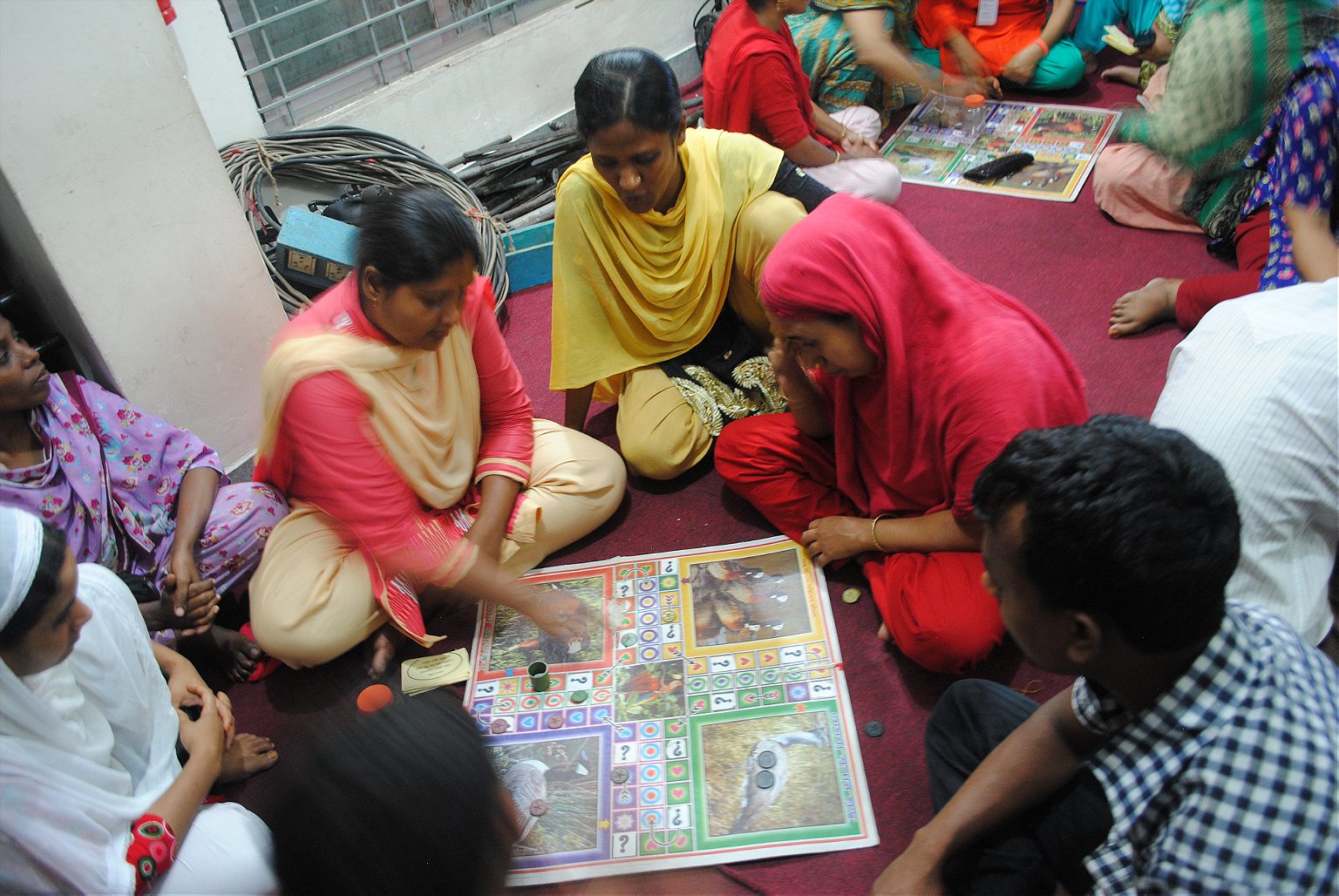
Management’s hostility to the gatherings eased when they learned the cafes emphasized not only workers’ rights but also their responsibilities, Morshed adds. For example, it is common for workers not to inform managers about absences.
Lucky Begum, a 27-year-old single mother wearing a yellow shawl, worked at a nearby sub-contractor factory that employed 300 people. The factory did not pay workers on time but Awaj staff intervened, resulting in regular payments.
“Previously we didn’t understand if wages were properly calculated,” Lucky says. “Now we understand if we are cheated or not.”
Khairul Islam, a 23-year-old wearing a shiny World Cup soccer jersey, worked with Lucky at the same factory. Even as the sub-contractor, employees did fire drills and wore face masks, he says. It’s a sign of increased safety awareness.
But the factory shut down in March, possibly due to dwindling business as international clothing companies crack down on factories using sub-contractors. Lucky and Khairul were paid one month’s severance; not long ago they would have received nothing. Both say there is no work back in their villages. So they are both looking for work at other garment factories.
A welder without protective gear was electrocuted in 2010
It takes systematic outreach, education, training, regulation, strict enforcement, and time to change factories in Bangladesh. And there are still many murky questions about what will happen to unregulated sub-contractors. Also distressing is that non-export garment factories only serving the domestic market don’t fall under international inspections.
Perhaps higher standards at other factories will eventually trickle down into unregulated ones, like at Lucky Begum’s sub-contractor. But in reality, few workplaces anywhere in the world truly change unless they have to or if there are incentives or support to do so.
A shipbuilding company called Western Marine in Chittagong is an unlikely example of sweeping safety changes. As recently as February 2011, Western Marine counted a staggering 1,000 injuries a month out of a workforce of 3,500. The injury rate was due to lack of basic protective gear and safety measures such as goggles, heavy shoes and gloves, harnesses, and sturdy scaffolding.
German aid agency GiZ approached Western Marine about starting a safety program when the company started selling ships to Germany in 2009. After a welder without protective gear was electrocuted in 2010, Western Marine hired an international safety consultant. The shipbuilder started a safety program and began training workers.
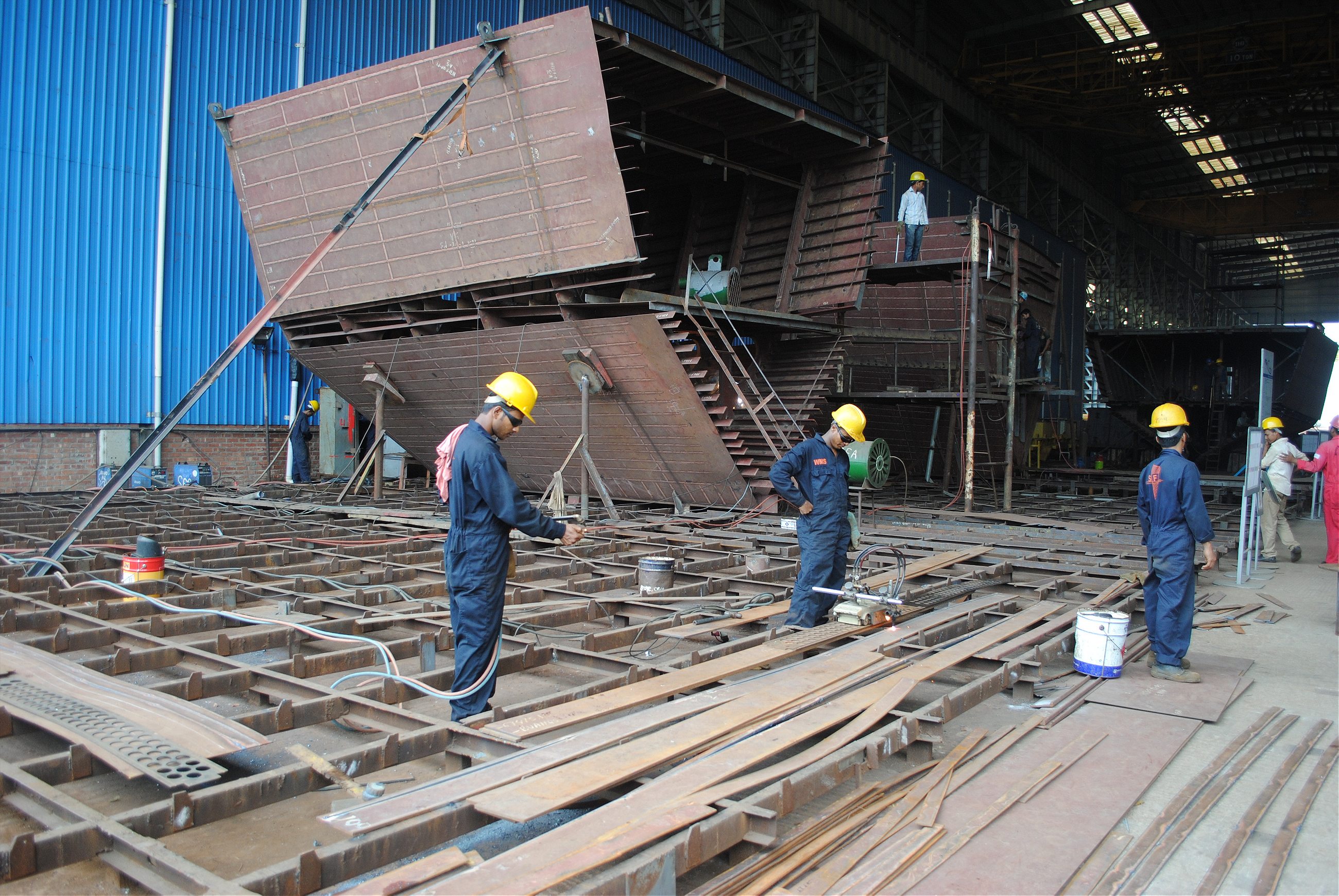
Within 15 months, Western Marine dramatically reduced its injury rate—by 99 percent, to 10 injuries a month by June 2012. At first, workers accustomed to wearing sandals in the hot climate did not want to wear protective gear. But those who didn’t follow rules were given warnings, further training and were even fined or fired. Western Marine also gave bonuses to workers who used proper safety gear. Rules were strictly enforced.
Indeed, during a visit to Western Marine’s shipyard, I saw workers wearing coveralls, hard hats, gloves, and goggles as they welded gigantic pieces of metal and operated shrieking machinery.
In August 2012, Western Marine was awarded OHSAS 18001, the global occupational health and safety management certification. It also received ISO 14001, the internationally recognized standard for environment management. The certifications led to new orders from buyers in New Zealand, Tanzania, and Kenya.
“Now, In Europe, no [ship] orders will be given to you without the certificates,” says Sakhawat Hossain, managing director of Western Marine. “Maybe we increased one percent in costs, but we saved 100 percent of our image.”
Of course, upgrading a single shipyard is easier than overhauling 3,500 factories, training millions of workers and creating a sustainable regulatory system. Transforming an entire industry in a few years and changing ingrained behavior would be a daunting task anywhere. In Bangladesh especially, nothing is easy, not even making a T-shirt. There is much more work to be done.
This story was produced in partnership with the McGraw Center for Business Journalism at the CUNY Graduate School of Journalism.